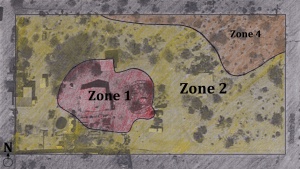Zone 1
The area around the house will feature an outdoor kitchen, a group meeting space, a large vegetable garden, rainwater storage tanks and a greywater-fed oasis zone on the west side.
Zone 2
Most of the site is “Zone 2”. In this zone, contour swales are being put in to slow, spread and sink rainwater across the property during our brief, but sometimes torrential summer rains. The trenches of the swales will have a thick layer of organic mulch to hold onto that moisture as long as possible and to build soil. These will be planted with a diverse mixture of very hardy food-producing trees, shrubs and cacti (along with dense plantings of nitrogen-fixing support species). Once the plantings on these swale systems are well-established, it is intended that they be gradually weaned off of any groundwater irrigation over a period of years. This mixture of mesquites and other unconventional food trees are designed to provide the main bulk staple foods produced on site.
The swales are narrowly spaced throughout zone 2 in order to create corridors of shaded, wind-sheltered productive space. Moving among these relatively narrow swale “alleys” will be a moveable chicken system, and rabbit hutch, and perhaps eventually one or two picketed, milking goats. These animal systems will be carefully managed to add fertility to the land and prepare small areas for main-crop planting.
Main crops of fast-cycle, drought-tolerant annuals will be sown immediately following adequate rain events in the spaces between swales. All main crops will be planted in long-lineage rows, on contour. Deep mulching, cover crops, compost, compost tea, and bio-fertilizers will be utilized in these areas in order to build natural soil fertility, decrease evaporation, and increase water retention.
Honeybees will be kept on the outskirts zone 2 as well.
Zone 4
This is a small, more wild area on the site which will be lightly tended, but mostly just protected and restored as much as possible.

